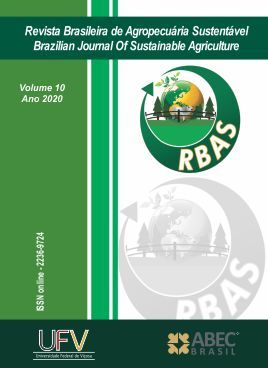USO DO CALCÁRIO E DO GESSO AGRÍCOLA EM DUAS ÉPOCAS DE IMPLANTAÇÃO DO Coffea arabica L.
DOI:
https://doi.org/10.21206/rbas.v10i1.9940Keywords:
Alumínio, Correção do solo, Crescimento vegetativo, TemperaturaAbstract
Brazil has a predominance of acidic soils and its correction is necessary to mitigate the effect of acidity on agricultural crops, especially coffee that is sensitive to pH and the amount of calcium in the soil. Thus, the aim of this study was to evaluate the effect of adding different doses of lime and gypsum and its effects on the agronomic characteristics of the coffee in two experiments with different growing season the deployment. The experimental design was in randomized blocks, with four repetitions in a 4 x 4 factorial scheme, where the first factor was constituted by increasing doses of limestone and the second by increasing doses of gypsum. The first experiment was conducted in the winter - summer period and the second experiment in the spring - autumn period. The variables analyzed were plant height (AP), stem diameter (DC), leaf area index (IAF), leaf dry matter (MSF), root dry matter (MSR) and root length (CR). When analyzing the averages of the experiments, it was observed that in experiment I, the AP showed values higher than in experiment II, with an increase of 1.84 cm in this variable. For the other variables DC, IAF, MSF and MSR in experiment II, they reached a higher increment compared to experiment I in the order of 0.4 mm, 9.08 cm2, 1.54 g, 4.12 g respectively. The doses of limestone and gypsum did not provide changes in agronomic variables in both the periods evaluated during the period of six months after transplanting.
Downloads
Downloads
Published
How to Cite
Issue
Section
License
Copyright (c) 2020 Brazilian Journal of Sustainable Agriculture

This work is licensed under a Creative Commons Attribution-NonCommercial-NoDerivatives 4.0 International License.
1. Proposta de Política para Periódicos de Acesso Livre
Autores que publicam nesta revista concordam com os seguintes termos:
Autores mantém os direitos autorais e concedem à revista o direito de primeira publicação, com o trabalho simultaneamente licenciado sob a Licença Creative Commons Attribution que permite o compartilhamento do trabalho com reconhecimento da autoria e publicação inicial nesta revista.











